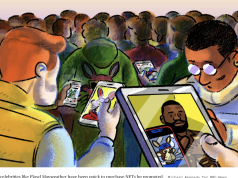McKinsey, May 24th, 2022
Talk of the metaverse has been ubiquitous over the past several months.1 In 2021, internet searches for the term increased by 7,200 percent. In December, Facebook rebranded itself as Meta, and CEO Mark Zuckerberg declared his ambition to “help bring the metaverse to life.” A month later, Microsoft said that its proposed acquisition of gaming giant Activision provided “building blocks for the metaverse.” Sidebar
About the authors
It’s not just talk; private capital is also rapidly pouring in. In 2021, metaverse-related companies reportedly raised upward of $10 billion, more than twice as much as they did in the previous year. In the past 12 months, one company alone—Epic Games, maker of Fortnite—has not only raised $3 billion to fund its long-term vision for the metaverse but also announced a partnership with LEGO to build a metaverse for kids. The global value creation opportunity from the metaverse could be in the trillions.
What, exactly, is the metaverse? Right now, the interested parties cannot agree on any one definition. But most descriptions—including this particularly insightful take from venture capitalist Matthew Ball, who recently shared his thoughts on the promise of the metaverse with McKinsey—have some elements in common:
MOST POPULAR INSIGHTS
- Supply chains: To build resilience, manage proactively
- How US consumers are feeling, shopping, and spending—and what it means for companies
- Advanced recycling: Opportunities for growth
- The state of grocery in North America
- Leading from the heart: How Freshworks’ CEO built a global tech unicorn
- The metaverse encompasses immersive environments, often (but not always) using virtual- or augmented-reality technology.
- The metaverse is “always on” and exists in real time.
- The metaverse spans the virtual and physical worlds, as well as multiple platforms.
- The metaverse is powered by a fully functioning virtual economy, often (but not always) built on cryptocurrency and digital goods and assets, including nonfungible tokens (NFTs).
- The metaverse enables people to have virtual identities, presence, and “agency,” including peer-to-peer interactions, transactions, user-generated content, and “world-building.”
We believe that the metaverse is best characterized as an evolution of today’s internet—it is something we are immersed in instead of something we look at. It may realize the promise of vast digital worlds to parallel our physical one. For marketers, the metaverse represents an opportunity to engage consumers in entirely new ways while pushing internal capabilities and brand innovation in new directions.
Now is the right time to adopt a test-and-learn mindset, to be open to experiments in the metaverse, and to move on quickly from failure and capitalize on success.
We do continue to see a healthy amount of skepticism about the metaverse, and companies may wish to exercise caution, since the promise may take some time catching up to the hype. But we believe we’re at the cusp of a fundamental shift in how people use the internet. (See sidebar, “Six reasons the metaverse is here to stay.”) Marketers would be remiss if they didn’t start exploring what the metaverse can offer. Now is the right time to adopt a test-and-learn mindset, to be open to experiments, and to move on quickly from failure and capitalize on success.
Six reasons the metaverse is here to stay
There’s ample skepticism right now from people who think the metaverse is just a flash in the pan. That’s also what some people thought about the internet during the 1990s. But then, as now, one thing was clear: although we didn’t know which companies would shape this new technological evolution, consumers were flocking to it. Increasingly high levels of consumer adoption propelled fundamental change.
Similarly, the attraction of consumers to today’s metaverse indicates a major shift in the way people use technology. If the metaverse is another evolution of the internet—something we are already in rather than something we observe from a distance—marketers clearly shouldn’t miss out.
Here’s why we think the metaverse has staying power.
- Ongoing technological advances. Technical challenges must still be overcome for metaverse experiences to be completely mainstream—for example, as a result of technical constraints, both Meta’s Horizon Worlds and The Sandbox cap the number of participants for each session. But constant improvements in computing power allow larger virtual worlds to exist. Cloud and edge computing let intensive large-data processes, such as graphics rendering, move off local devices. The rapid adoption of 5G is enabling mobile devices to access these large worlds more easily and with lower latency. And the cost of production for augmented- and virtual-reality hardware is declining. Meta shipped ten million Oculus Quest 2 headsets in 2021, and new devices like haptic gloves and bodysuits are coming on to the market more frequently as well.
- Major investments in metaverse infrastructure. In 2021, Meta invested $10 billion in the metaverse. Other tech companies have also committed resources to building it—such as the recent launch of the design and simulation platform NVIDIA Omniverse and recent metaverse-friendly updates from Unity Engine, a game developer platform. For good reason, the metaverse dominated this year’s Consumer Electronics Show. More and more companies, large and small, are keen to participate.
- A wider set of use cases. Gaming in the metaverse already has mainstream traction. Consumer use cases are now expanding into new immersive retail, entertainment, sports, and educational experiences. Then there are the metaverse’s sizable—but less talked about—enterprise applications and opportunities, including virtual employee training and team collaboration with avatars, virtual prototyping in manufacturing and construction, and virtual-showroom displays for products such as cars. Even government entities are experimenting with the metaverse. In South Korea, the city of Seoul announced a five-year Metaverse Seoul Basic Plan that will begin by creating a virtual Mayor’s Office and a Seoul Campus Town.
- Online commerce is mainstream. Already, omnichannel commerce is second nature to most metaverse consumers—payment credentials are often embedded in the devices and software they use. The virtual-goods economy accounts for more than 40 percent of global gaming revenues generated by the world’s billion gamers. In the future, the long-term rise of cryptocurrencies will make any requirements to set up crypto wallet accounts on metaverse platforms less of a barrier. Already we see innovation in both physical-to-virtual and virtual-to-physical transactions, such as ordering Domino’s pizza in Decentraland for deliveries of actual pizza in the real world.
- Demographic tailwinds. The oldest Gen Z consumers are in their mid-20s. Increasingly, they are an income-earning force to be reckoned with. These consumers are more familiar with virtual worlds, transactions, and goods than previous generations are. Gaming is leading the way: 67 percent of Roblox’s 50 million daily users are under the age of 16, which could signal the coming of a whole new generation of metaverse natives.
- Brand marketing and engagement are more consumer led. The shift toward individual content creators is evident in the more than 50 percent increase in influencer marketing over the past five years on platforms such as WeChat and Pinduoduo in China and YouTube and Instagram in the Western world. This shift bodes well for the growth of the metaverse: a significant share of innovative and engaging experiences will probably come from these creator–users.
Rewriting the rules of marketing for the metaverse
We may still be in the first wave of consumer engagement with the metaverse, but lessons are already emerging from companies that found early success. In some ways, the critical elements of marketing in the metaverse resemble those of designing authentic and compelling brand experiences in the physical world. But the application of these elements in the metaverse can be very different. Much as approaches for driving value online continue to evolve, the effective engagement of consumers in the metaverse will require its own evolving recipe for success.
Here’s what this landscape looks like today and how organizations can think about their metaverse marketing strategies for the future.
Define your metaverse marketing goals. Why do you want to be part of the metaverse? If your brand’s consumers are there, do you want to increase awareness among new audiences, position your brand and generate favorable sentiment, or promote loyalty? Is your goal to spark innovation in your marketing team? For the near term, the primary goal of brands shouldn’t be driving sales directly, since sales of virtual items are still far smaller than sales of physical ones. What’s more, today’s metaverse audiences, especially on online entertainment platforms like Roblox, often skew younger, which brings both opportunities and risks.
Identify the platforms that provide the best opportunity and brand fit. Right now, Roblox, Fortnite, Decentraland, Minecraft, and Meta’s Horizon Worlds are just a few of the metaverse games and platforms out there. Some will be better than others for specific purposes. There is ample opportunity to experiment with multiple platforms to see what works. For example, the luxury brand Gucci has conducted multiple brand activations to figure out where and how to connect with Gen Z. Last year, it drew 19.9 million visitors in two weeks when it launched a metaverse version of its real-world Gucci Garden on Roblox. Gucci has also partnered with the fashion-focused metaverse Zepeto, announced plans to launch a virtual world on the blockchain-based platform The Sandbox, and created assets for games including The Sims, Pokémon GO, and Animal Crossing.
Design experiences appealing to target audiences. Consumers tend to see brands in the metaverse as innovative, so the bar for delivering innovative experiences is high. Companies need to determine the ideal balance between native advertising, immersive experiences (including games, virtual stores, events, and sponsorships), and real-world activations to complement the metaverse. Take, for example, what the skateboarding retailer Vans did last fall when it launched the interactive skatepark “Vans World” on Roblox. To build brand awareness and appeal to the company’s core demographic, Vans enabled visitors to virtually explore skate sites with friends. Visitors can also earn points through gameplay to spend on virtual sneakers and apparel items, as well as to build customized skateboards in a virtual skate shop. This has successfully engaged both existing and new fans—and has seen more than 48 million visitors so far.
Consumers tend to see brands in the metaverse as innovative, so the bar for delivering innovative experiences is high.









